If you’ve ever gone into a holistic or spiritual store, surely you’ve run across Tibetan and Himalayan bowls. Maybe you’ve seen them on your travels as I first did when I first traveled to India and Nepal three decades ago. I found them again on my travels in southern and eastern Africa and again on my trip to Qatar.
They are everywhere and won’t be new to travelers who have explored Asia and other popular destinations that use bowls for ceremonies or healing. I’ve always loved them and have had a few medium sized bowls I picked up on my travels that I have used during events from time-to-time or when we meditate. And, a couple of years ago, I reviewed a couple of bowls and a gong.
It wasn’t until I completed Minna’s sound healing course recently that I picked up a deeper interest as I experienced their power for not just opening up and clearing chakra but for other forms of healing as well. The tonality is so different than the crystal bowls I use in our sessions, so I had to dive deeper.

I came across Best Singing Bowls in my research, which appeared to offer the most comprehensive set of offerings I could find. Not only that, the breadth and depth of their bowl selection was so expansive, that I found myself losing hours of time listening to the different tones of the countless bowls they offer. And, so many choices! Where to begin?
And, so I reached out to the folks behind Best Singing Bowls and are thrilled to have the opportunity to review a set that founder Ryan Sarnataro customized for me based on a couple of conversations we had about my styles and preferences. It’s one of many things that sets Best Singing Bowls apart from others on the web.
Meet Best Singing Bowls
Best Singing Bowls specializes in providing great sounding antique Himalayan and Tibetan singing bowls. They’ve been around since 2008 and as such, they offer a wide range of choices — and we mean a wide array of choices.

You can get a carefully crafted singing bowl set or purchase more unique antique bowls as one-offs. Of course they offer tons of accessories as well such as mallets and ringing implements in order to truly bring out the full range of sound. Other goodies you’ll discover are embroidered cover cloths and woolen mats hand made by the Tibetan community in Kathmandu.
Their website offers antique bowls dating from the 15th to the early 20th century.

Best Singing Bowls offers an expansive selection of bowls, ranging from different styles, tones, notes, sizes and beyond.
How to Find a Bowl or Set of Bowls for YOU!
One of the things that we really love about the Best Singing Bowls website is their COMPARE feature, which lets you select up to a dozen bowls and then view them in whatever sequence you wish. This is a great way to hear subtle differences and ring groups together.

Each Tibetan singing bowl they show has two sound clips, so you can actually hear the tone of the bowl in advance. What an amazing feature right?
The first tone you hear is a simple long strike with a mallet while the second one features the rim being played with a ringing stick or wooden wand. Recordings are unenhanced and natural.
This allows you to clearly hear the pure healing tones. They also offer a few different photos with different views and close-ups which so few sites offer.
You can also narrow your choices by selecting ranges of size and price or notes, octaves and types. When I first started looking at which bowls to select to review, it was a bit overwhelming. For example, with the crystal bowls we have, I wanted a bass and a higher tone for each of the notes that correspond to the chakras (C for the root chakra all the way up to B for the crown). In this way, I would have two different tones for each of the chakra notes that I could use for healing.
With Tibetan bowls, it’s a little different because the depth and size of the bowl impact how the note will sound and the thickness of the bowl determines how it will sound as well.
So, rather than focus on an entire “note” set, I had to look at the different styles, depths, shapes and so on. Luckily the site is so comprehensive, that not only can you hear how each bowl sounds, and see what they look like but you are also given exact weight and measurements as well.
The first tone you hear is labeled by its exact frequency in Hz and overtones are described by the note and octave. Ryan and his team also include a description that describes the sound and bowl as well.
Let’s now take a look at some of the bowl types they offer, so you can get a better understanding of what makes each unique.
Manipuris
If you’ve come across a singing bowl in a store, chances are you’ve seen or even played with a Manipuri bowl, as these are known as the original singing bowls.
When singing bowls first were introduced to the West back in the 1970’s, this was likely what you saw at the time. Most of the earlier Manipuris that hit the west came from Tibet on the back of refugees. The name Manipuri, however, apparently comes from a state in Northeastern India.
There are tons of different style Manipuri bowls, but because they were used so much, over time the bowls became thinner and thinner with expanded use. And, of course, the etchings and markings eventually worn off as well.
Manipuri singing bowls are found in a variety of sizes and many of the ones I’ve come across over the years are quite small. You’ll see them as little as three inches and larger ones can be around a foot long or more.
Because of the wide range, Manipuri singing bowls have a very wide range of primary tones, from the lower second octave to the top of the 5th. It’s also worth noting that the shape of Manipuri bowls gives them a timbre that blends well with the Jambati singing bowls, which we discuss below.
Jambati Bowls
I fell in love with these visually when I first saw them — bear in mind that this was simply based on their shape and design and before I ever heard one played.
The Jambati singing bowls often have visible hammermarks which exude old and authentic, at least to me. There are classical etching lines on Jambati bowls which are often found below the rim on the outside and circular markings inside at the bottom. Some very old Jambati have no etchings or lines left, a bit like the frequently used Manipuris we discuss above.

Beautiful Jambati Bowls
I discover through my research on their site and from talking to Ryan, that the older Jambati singing bowls were made with a flattened rim. For example, very old examples can have a broad flat rim with its own set of etched lines. These have become quite rare in recent years.
Jambati bowls were often used for relatively clean purposes such as grain storage so bowls hundreds of years old can have a high level of preservation. The Jambati style, especially darker ones possibly indicating the presence of thunderbolt metal (iron), were apparently preferred by Tibetans.
The vast majority of Jambati are in the 2nd and 3rd octave with an occasional small extra thick bowl ringing at the very low end of the middle octave.
Thadobati Bowls
This name intrigued me when I first saw it and then when I learned more, I could see because of their flat bottom that they might be useful for healing use on the body — Manipuris are harder to put on the tummy or a body part because their bottoms aren’t as flat as the Thadobati bowl for example.
the Thadobati bowls are defined by relatively vertical sides and a flat bottom. Some Thadobati singing bowls are rounder then others however the most common ones have a bottom diameter only slightly smaller than the diameter of the opening. The other thing to note here is that Thadobati singing bowls are relatively deep, up to 5″, while a 9″ diameter is about the largest size you will see in this style. The depth of course gives it a deeper tone, which I prefer overall.
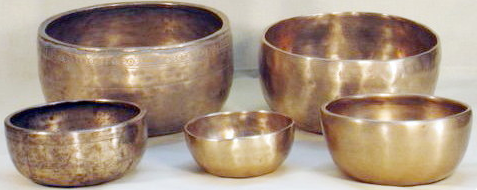
Thadobati Style Singing Bowls
It is said that the Thadobati style may be the most ancient common singing bowl, with simple thick examples dating back well over 500 years. The Thadobati style, especially those with a high copper content and a golden color were apparently preferred by Nepalese.
Singing bowls in the Thadobati style range in tone over four octaves, the widest range of any style. Says Ryan, “It would be possible to put together a hundred bowl set, all with discernably different strike tones. Thick small Thadobati bowls can be very high well up into the 6th octave while thinner large bowls go down to the bottom of the 3rd.”
Remuna Bowls
Remuna singing bowls are similar to Thadobati in both shape and timbre. Since they have a similar soundscape they can apparently mix seamlessly with Thadobati in sets. This is one of the things that again sets the folks at Best Singing Bowls apart — by reading through the research and the different styles, you can learn about the tones and types so you can figure out to pair your own set depending on what kind of sound experience you’re trying to create.
A main difference between a Remuna and a Thadobati is the Remuna singing bowls have inward sloping walls to go with their flat bottom.

Remuna Singing Bowls
Remuna bowls are known for their etchings and artwork. I learn that it is not uncommon for Remuna bowls to have two textures outside, with a darker and rougher bottom half of the bowl. Inscriptions are more common on Remunas than any other type bowl so if design is your thing, then perhaps you’d like to look at a Remuna bowl as one of your choices. Remuna bowls also tend to be thinner than Thadobati bowls as well.
Less Common Styles
Less common styles include the Pedestal Singing Bowl or “stand” bowls, which are sometimes known by the more prosaic name “Naga”. These bowls have a rounded bottom and an attached base so the bowl can be placed on a flat surface. Inscriptions are common on pedestal bowls, some of which indicate ceremonial use.
Pedestal bowls are generally on the thinner side though some older ones can be quite thick. Sizes range from roughly four to ten inches and correspondingly, the range of notes is large, from the third to sixth octave.
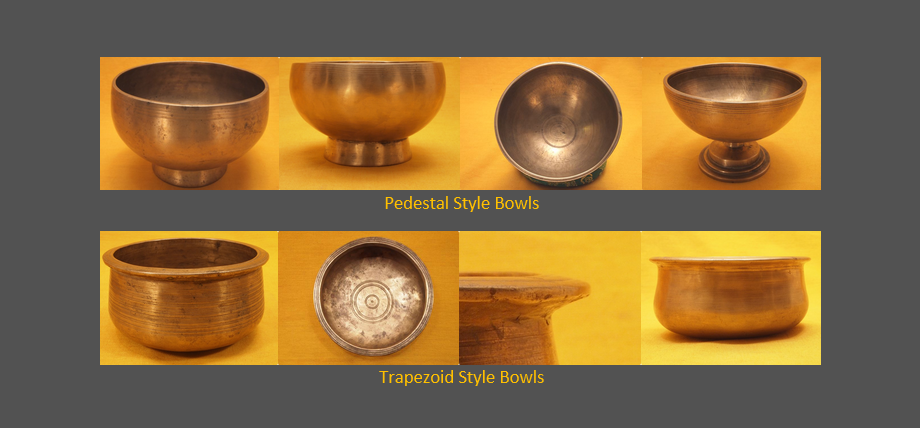
Another rare type of singing bowl is the Trapezoid Singing Bowl, which has its own unique shape. Trapezoid bowls come in two distinct groups of sizes, small ones are around 5 inches, large ones 7-8 inches. The small ones tend to be high, 4th and 5th octave while the larger ones, very difficult to find with good sound, are lower than you would expect for being only two inches larger.
Ultbati Singing Bowls are also not as common. Similar to Jambati style bowls, they are often found in sizes over 7 inches. Their distinguishing feature is that the side of the bowl is curved in under the rim. Beautiful, right?

Examples of Ultabati Bowls
These bowls are uncommon as noted above, which makes it more difficult to find with better sound quality. Ultabati bowls often have prominent hammermarks. They can come darkened, even black, on the outside and bright in the interior. Etching lines are similar to Jambati bowls but much less common.
My Experience with the Bowls
As I mentioned above, Ryan and I chatted on the phone and he put together a set for me based on how I plan to use the bowls, for what purpose and where. Of course, you can create your own set or just buy one antique one with a tone that you fall in love with — there is no right or wrong way to purchase a bowl.
Here’s a short video of my experience — I am having so much fun with these bowls.
You’ll resonate with the sound, the tone, the frequency, the shape or you won’t. And, that’s the beautiful thing about their site since you can experience all of the above with ease.
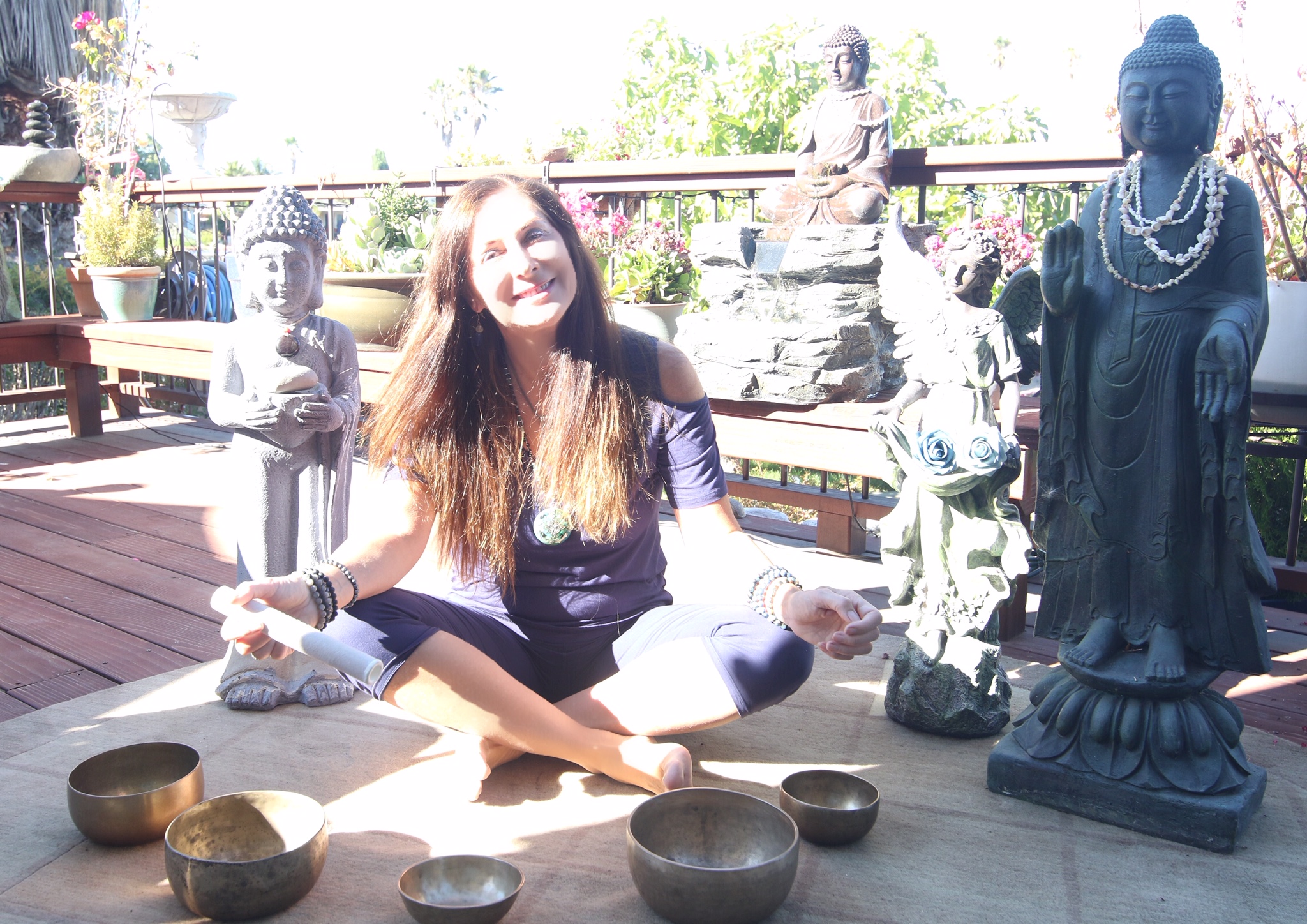
He created a set for me that would fit snugly together should I want to store them easily. And, he selected a range based on some of the tones I told him I liked from playing around on the site, which btw you can do for hours, there’s so much to choose from….
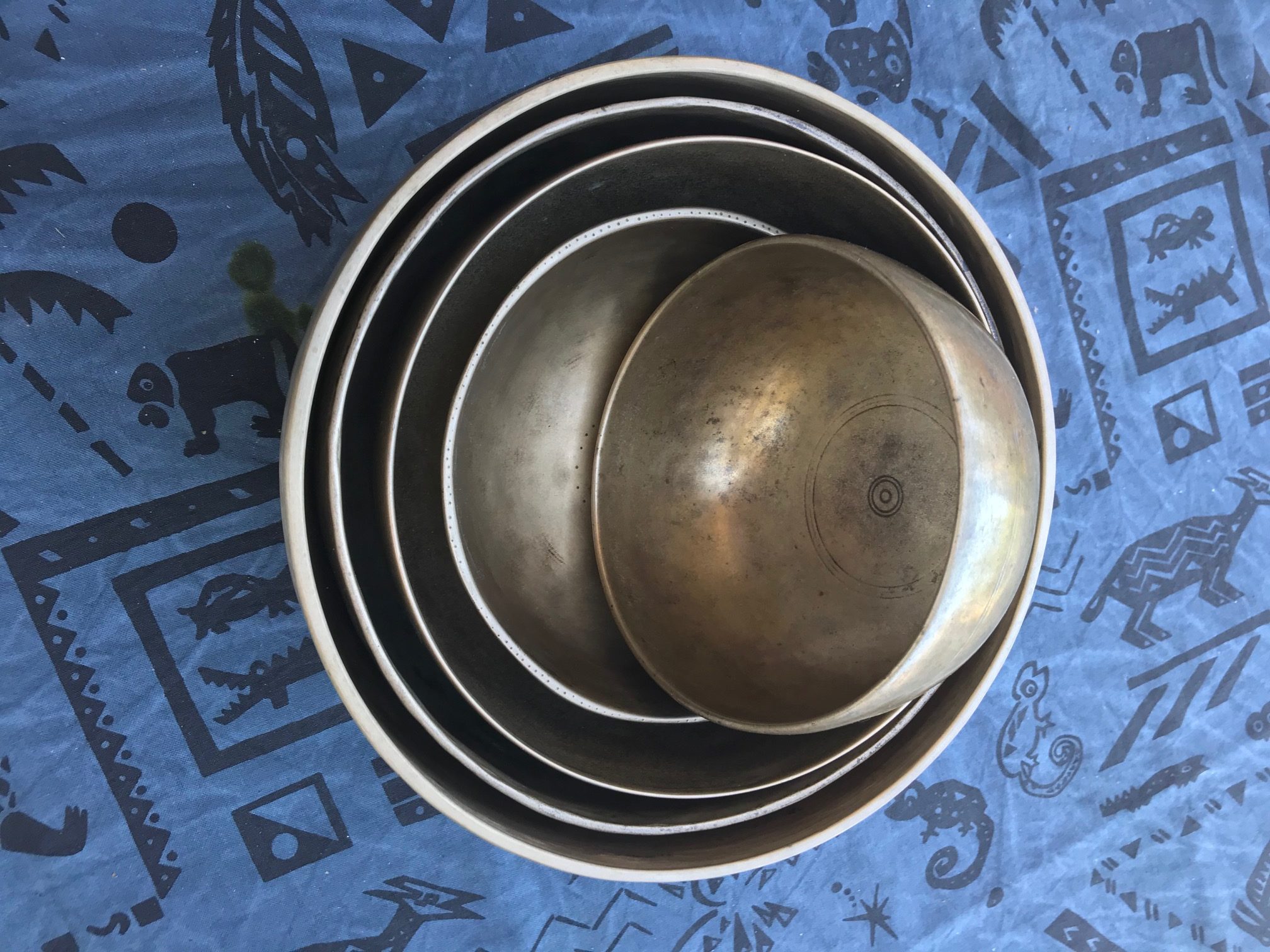

Learning Resources
The Best Singing Bowls website offers a wealth of information so you can learn more about how to buy and play a bowl — and of course, why one may be a better choice for you and why. They offer pages that range from how to use a singing bowl and how to play a singing bowl to a whole section on singing bowl therapy with a link to a researcher using Tibetan bowl healing for post traumatic stress. And, much much more.
Nifty Compare Feature
Their nifty compare feature makes it easy to narrow down what type of bowl (or set of bowls) you want. One of the things I love about the site is how easy it is to not just learn about the various types of bowls that are available but select based on size, note, price, region of the world, type of bowl and tone. there are tons of filters to choose from and you can listen to the sound of the bowl as well before you make a decision.
The software allows you to save a list and email yourself a link that will bring you back to your selection of bowls later on, so you can edit it accordingly as you learn more throughout the selection process. In this way, you can do your research over time and have fun in the process.
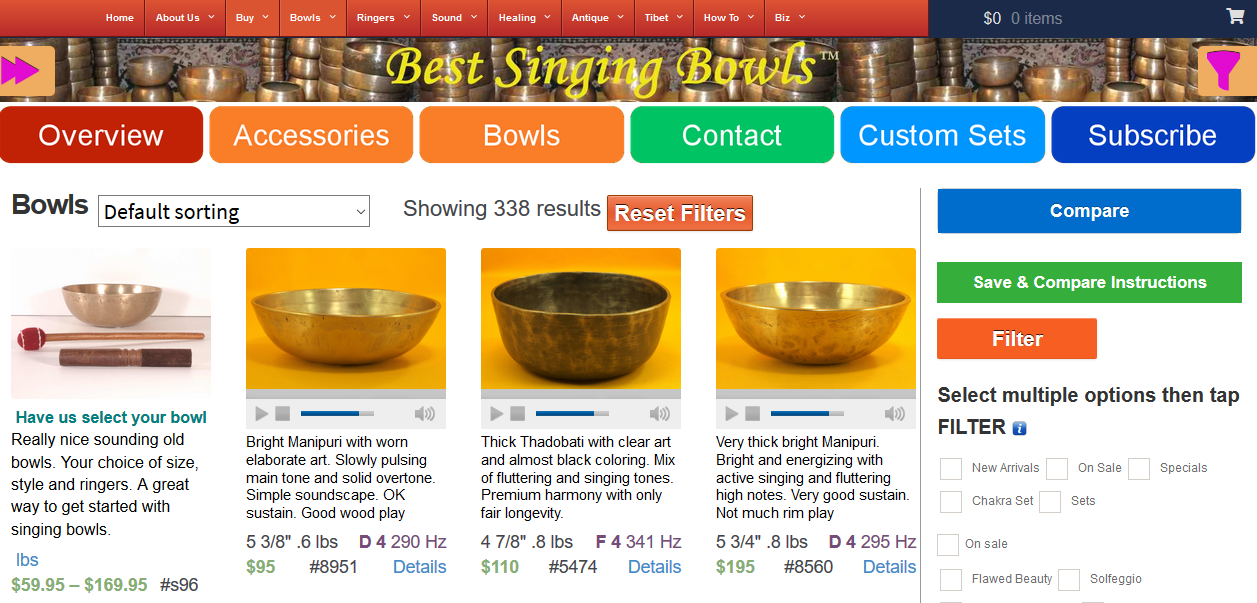
One other thing to note: if you are looking for a specific style, size or note that you don’t see listed on their site, chances are that they have it in backstock. This expansive inventory, combined with their expert sound matching experience over dozens of years means that they can assemble sound healing sets that cater to your needs as well as bowl sets that can be used for chakra healing and meditation.
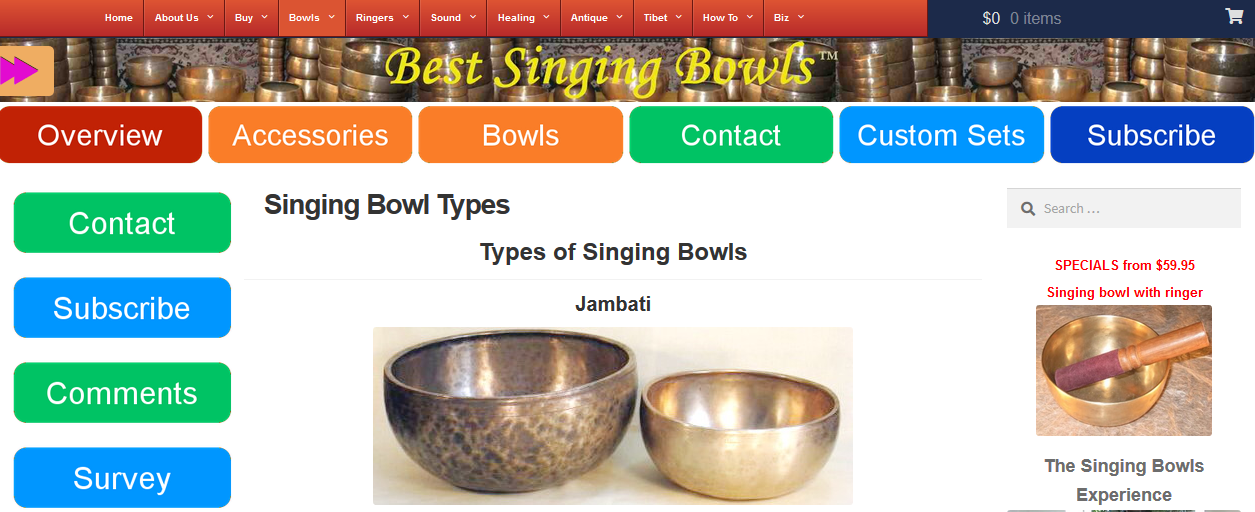
Behind the Scenes
The voice and powerhouse behind Best Singing Bowls is Ryan Sarnataro who began collecting over 30 years ago. He says that the bowls ignited his interest in Tibet and Tibetan Buddhism.
His many paths of study are all a part of an approach to what are sometimes called “prayer bowls”. These range from the Buddhist retreats and the profound teachings he’s experienced over the years.

Ryan Sarnataro in the Himalayas
On a very different level, Ryan says that his journeys into the scientific and statistical sides of sound and frequencies help ground his understanding of the bowls in consensus reality.
“There is a part of me that longs to reach back and touch the people and time from which these amazing sounding bowls of many metals arose.” — Ryan Sarnataro, Founder of Best Singing Bowls
For more information, visit their website.

Renee Blodgett is the founder of We Blog the World. The site combines the magic of an online culture and travel magazine with a global blog network and has contributors from every continent in the world. Having lived in 10 countries and explored nearly 80, she is an avid traveler, and a lover, observer and participant in cultural diversity.
She is also the CEO and founder of Magic Sauce Media, a new media services consultancy focused on viral marketing, social media, branding, events and PR. For over 20 years, she has helped companies from 12 countries get traction in the market. Known for her global and organic approach to product and corporate launches, Renee practices what she pitches and as an active user of social media, she helps clients navigate digital waters from around the world. Renee has been blogging for over 16 years and regularly writes on her personal blog Down the Avenue, Huffington Post, BlogHer, We Blog the World and other sites. She was ranked #12 Social Media Influencer by Forbes Magazine and is listed as a new media influencer and game changer on various sites and books on the new media revolution. In 2013, she was listed as the 6th most influential woman in social media by Forbes Magazine on a Top 20 List.
Her passion for art, storytelling and photography led to the launch of Magic Sauce Photography, which is a visual extension of her writing, the result of which has led to producing six photo books: Galapagos Islands, London, South Africa, Rome, Urbanization and Ecuador.
Renee is also the co-founder of Traveling Geeks, an initiative that brings entrepreneurs, thought leaders, bloggers, creators, curators and influencers to other countries to share and learn from peers, governments, corporations, and the general public in order to educate, share, evaluate, and promote innovative technologies.










